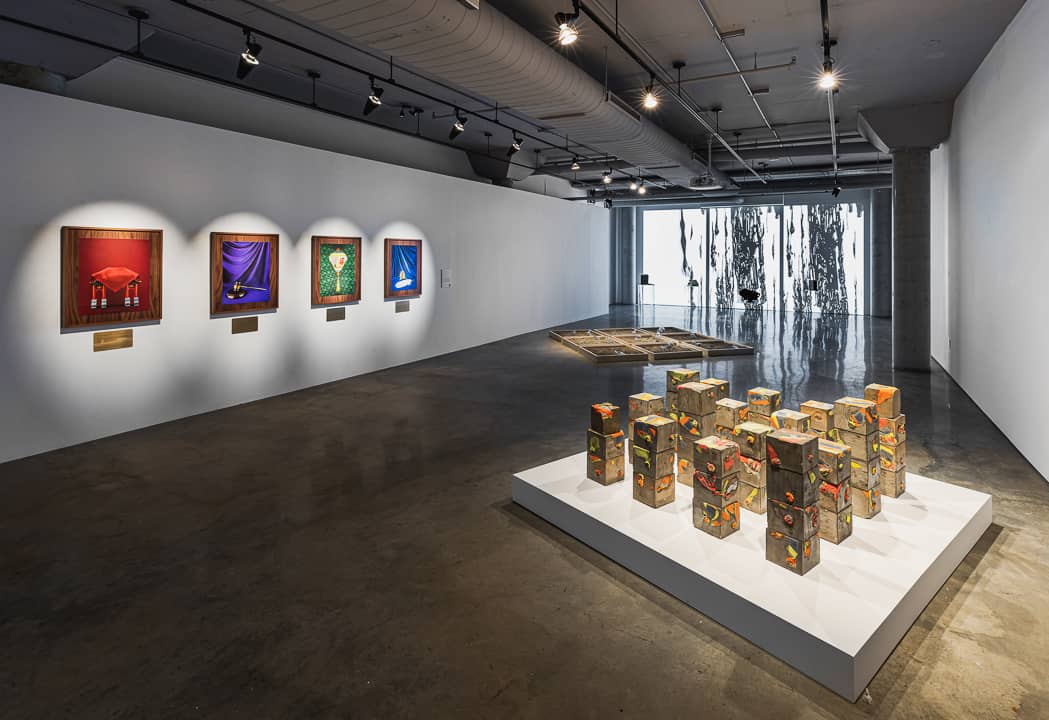Content warning: This article contains discussions of systemic racism.
The page for UTSC’s Doris McCarthy Gallery on its Nostalgia Interrupted exhibition opens by using fear-mongering words like “terror,” “aggression,” and “insidious” to describe the status of Black, Indigenous, and people of colour (BIPOC) in our current society. This introduction foreshadows the doomsday-core exhibition that is to come. Nostalgia Interrupted is a commentary on the idea of reminiscence, and how racialized people do not have the luxury of looking back on history with a sense of joy in the same way white people might. It claims that classic nostalgia looks at the world with “rose-coloured idealism,” but then swings the pendulum in the opposite direction by exhibiting works that are fatalistic and pessimistic, without answering the question: is either extreme good?
The problem with this exhibition is not the individual artists and their work, but the curation of their art together. Alone, some pieces in the Nostalgia Interrupted series stand as powerful critiques of the racist structures that rule Canada. For example, “Deer in Headlights” by Algonquin artist Caroline Monnet uses stacked concrete blocks to critique the political oppression of Indigenous peoples, by visually representing how late in history Indigenous peoples gained the right to vote.
“Sebastia” by Dima Srouji uses glass-blown artifacts placed in sand-filled boxes to critique archeological practices of taking non-Western artifacts for display in the Western world. Alone, these works may be interesting, but together, they become a repetitive oversimplification of lived experiences of racialized people. Together, they leave the viewer wondering, is this all that racialized people are? Victims of circumstance?
Nostalgia Interrupted follows the practice of “trauma feeding,” which is a practice in the arts that arouses moral sympathy while institutions capitalize on the suffering of marginalized groups. By using shock value and moral panic, an artist engaging in “trauma feeding” sensationalizes the lived experiences of vulnerable groups. This empty despair and unnecessary melodrama brings more uninvited pain to racialized viewers.
One example of this is the exhibition’s incredibly dim lightning. The effect casts a shadow on the already depressing art, and yet it does not feel moody; it instead feels like overkill. Secondly, some of the work was closer to the floor than it should have been — again, this may have been a way of forcing us to look down at the art, hunch our shoulders, and make us look as contorted as the art made me feel. Throughout the exhibition, it was clear that the curators went out of their way to exploit viewer emotions to arouse sympathy — but they elicited nothing but pity.
The problem with this exhibition was not that it pointed out the hard realities that racialized people faced, and are still facing in Canada today. Highlighting such experiences is necessary to create positive change. Other galleries in Toronto have done this successfully, such as the Dis/Mantle exhibition by Gordon Shadrach — which is currently running at the Spadina Museum. This exhibition shows the lived experiences of a Black American freed slave who came to Canada and worked as a laundress in the Spadina Mansion. Although it was realistic about the harsh reality that she faced, it also centered Black perspectives, beauty, and independence.
Similarly to Nostalgia Interrupted, Dis/Mantle also had a focus on the experiences of racialized people in the past. Instead of framing them as victims and helpless damsels, it centered their reclamation of power. The issue with Nostalgia Interrupted is that it only focuses on hardship and completely disregards any opportunity to highlight the community and progress racialized people have made. Although each artwork had strengths, when put together, the Doris McCarthy Gallery created an ode to misery and stagnancy and invites viewers to wallow in it.
The entirety of this exhibition was draining and demeaning, and I left feeling sad and hopeless. There is nothing wrong with art making an audience emotional; however, when that emotionality lacks a call to action and glimmers of hope, it rings hollow. Especially in relation to art that depicts racialized people, a more holistic perspective is necessary. Without one, marginalized people become reduced to their suffering, a caricature of their whole selves. This exhibition lacked both a call to action and a glimmer of hope, and it almost seemed like it called for people of colour to collapse and die because nothing will ever change.


